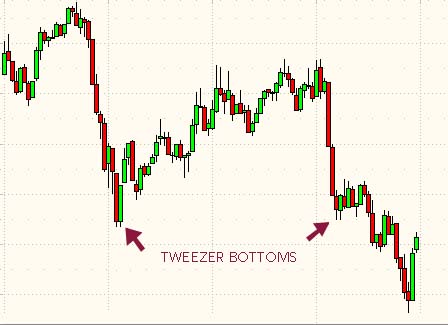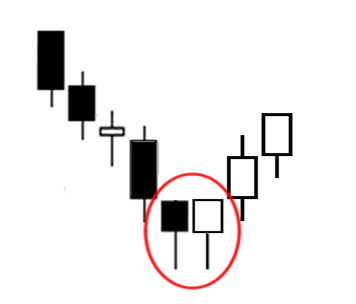Last Updated: March 2, 2017
It doesn’t matter if the candles are short or tall. It doesn’t matter if they’re black or white. In fact, it doesn’t even matter if there are two, five, or even ten candles! Just like the Tweezer Top candlestick pattern that we discussed earlier this month, the Tweezer Bottom candlestick pattern is formed by multiple candles in any color or size. The only crucial, distinguishing feature of this signal is that all of the candles involved must have the same low point. To learn more about the Tweezer Bottom’s formation and meaning, simply scroll down.
Tweezer Bottom Candlestick Pattern
Formation
Do you think you’ve spotted a Tweezer Bottom candlestick pattern? To identify this bullish signal, look for this (very flexible) criteria: First, there must be two or more adjacent candles of either color. Second, a clear downtrend should be present. Third, those candles must reach the same low point.
It’s generally easy to identify a Tweezer Bottom because the criteria is so simple. Once you have a downtrend, simply look for identical low points. Although we don’t recommend that you completely ignore the body color and the shape of the candles, these factors are not critical components of the signal.
Finally, if you notice the opposite of this signal (i.e., an uptrend followed by multiple candles that have the same high point), you have probably spotted a Tweezer Top candlestick pattern, which is a bearish reversal signal.
Meaning
The depth of this signal’s lower shadows signifies an area of support. The bears were not willing to sell below that lowest price, so the bulls returned in great force and pushed the price back up. The fact that two or more candles formed with shadows at this same level confirms the strength of the support and shows that the downtrend will likely pause or reverse into an uptrend.
Like the Tweezer Top, this signal is viewed as a minor, short-term reversal pattern. To better understand its meaning, keep an eye out for these characteristics:
- If this pattern appears at market lows, it is more reliable.
- If the first candle has a large body and the second has a short body, the reversal is more reliable.
- If the Tweezer Bottom is followed by another reversal pattern, such as a bullish Engulfing or Piercing pattern, with identical lows, it is even more reliable.
EXAMPLES

As you can see from the trio of examples above, Tweezer Bottom patterns are shapeshifters. Their appearance can drastically change from one chart to the next, so it’s important that you thoroughly understand the criteria that defines this signal. To help broaden your idea of what a Tweezer Bottom looks like, and to ensure that you’re ready to locate it in the wild, we’ve selected four examples of this pattern that you can use to test your knowledge.
EXAMPLE 1:
In this first example, a downtrend emerges about two-thirds of the way through the chart. After a few significant downward jumps, a long red candle is followed by a long tan (bullish) candle, forming the Tweezer Bottom. At first, the investors are indecisive; the session closes and opens at nearly the same spot, forming a doji. However, as expected, the price then shoots upward over the course of several sessions. An uptrend has emerged.

EXAMPLE 2:
In our next example, the price progressively dips lower and lower as the chart goes on, steadily forming a downtrend. At the bottom, a red candle is followed by a much longer blue candle. The bullish session opens at the same place the bearish session closed, creating a Tweezer Bottom. Then, two doji appear. This period of indecision might cause you to doubt the Tweezer Bottom, but in fact, the longest candle of the entire chart materializes, solidifying the uptrend.

EXAMPLE 3:
In this example, we ride the rollercoaster a bit before descending to the lowest point on the chart. The low point of the red candle matches the opening of the subsequent green candle, assembling a Tweezer Bottom candlestick pattern. Although the next candle is red, it does gap up. This might cause you to lose your cool, but if you’re patient, you’ll see an uptrend form. Success!

EXAMPLE 4:
Finally, our last example is twofold. Though it contains two Tweezer Bottoms, they differ in their ability to forecast the future. The first signal forms at the bottom of a downtrend when the bottom wicks of a red candle and a green candle hit the same spot. The price escalates as expected. No surprises here.
When the price finally plummets with a few significant dips, another Tweezer Bottom forms. Upon noticing that the duo’s bottom wicks have reached the same spot, you might ready yourself for another uptrend. Unfortunately, the uptrend that occurs is very subtle and brief. Soon, we’re plunging downward again. This example demonstrates the importance of confirmation. If you had waited until the day following the Tweezer Bottom to take action, you would see that the subsequent candle does not trade above the two candles in the signal. Best to hold off.
_____
The Tweezer Bottom candlestick pattern is a useful signal, but it can be misleading, so before you act on it, be sure to check for confirmation. Be sure that the price is trading above the level of support. If the price is trading above the bodies of the Tweezer Bottom candles (a bullish movement), it is likely that the trend has reversed instead of a change to consolidation. Good luck!
If you’re interested in mastering some simple but effective swing trading strategies, check out Hit & Run Candlesticks. Our methods are simple, yet powerful. We look for stocks positioned to make an unusually large percentage move, using high percentage profit patterns as well as powerful Japanese Candlesticks. Our services include coaching with experienced swing traders, training clinics, and daily trading ideas. To sign up for a membership, please click here.






Comments are closed.